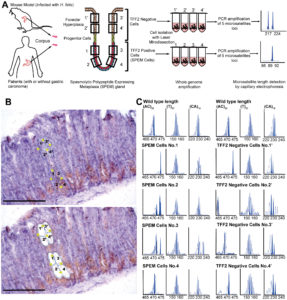Spasmolytic polypeptide expressing metaplasia (SPEM) is present in more than 90% of resected gastric cancer tissues. However, although widely regarded as a pre-cancerous tissue, its genetic characteristics have not been well studied. In this work, we show for the first time that elevated genetic instability is a critical property of SPEM cells (TFF2 positive cells in SPEM glands) in both H. felis-infected mouse models and clinical samples. Unexpectedly, we also found that TFF2 negative cells in the same SPEM glands also exhibit substantial genetic instability. These results implicate stem cells of the SPEM glands as potential key players in carcinogenesis.
Figure. Extensive MSI was found in SPEM cells and TFF2 negative cells of the mouse model infected with H. felis. (A) A detailed view of the experimental workflow. (B) Four sub-segments of SPEM cells and four sub-segments of TFF2 negative cells in SPEM gland 1 from H. felis-infected mouse (15 months) were isolated with laser microdissection. (C) The length variations of microsatellite markers in these 8 isolated sug-segmants detected with capillary electrophoresis. Bar = 150 µm (Dr. Yan Guo, https://jmg.bmj.com/content/early/2019/03/15/jmedgenet-2018-105752 )
